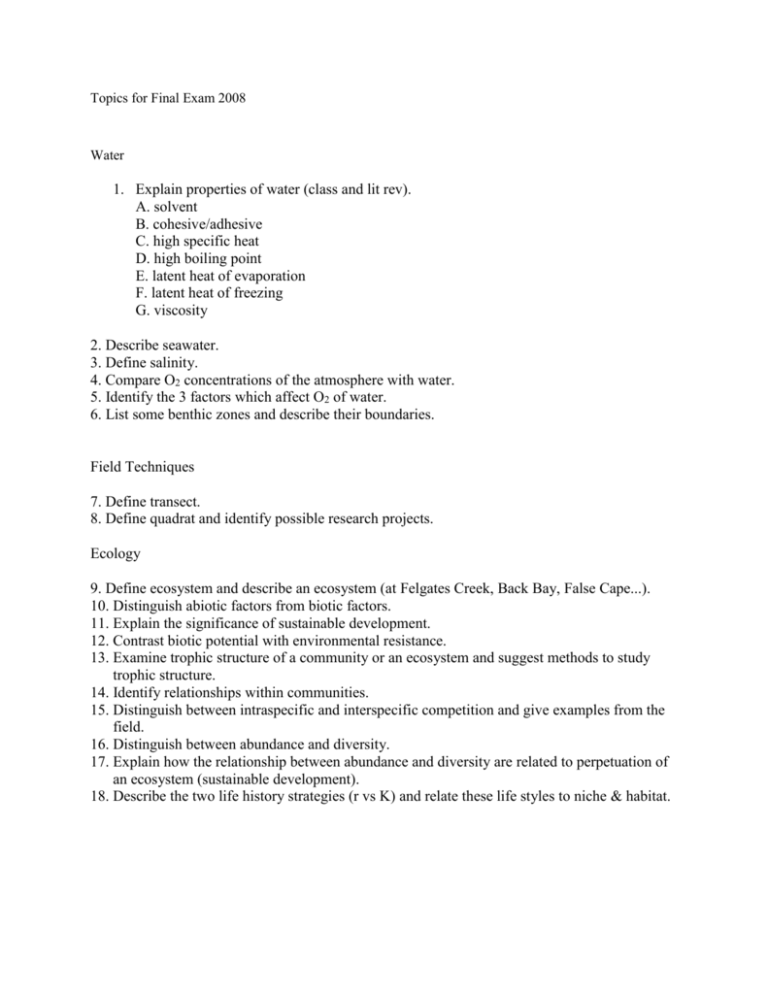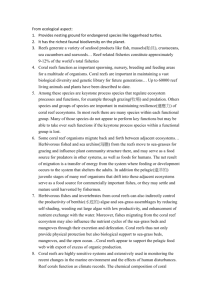Final Exam Review
advertisement

Topics for Final Exam 2008 Water 1. Explain properties of water (class and lit rev). A. solvent B. cohesive/adhesive C. high specific heat D. high boiling point E. latent heat of evaporation F. latent heat of freezing G. viscosity 2. Describe seawater. 3. Define salinity. 4. Compare O2 concentrations of the atmosphere with water. 5. Identify the 3 factors which affect O2 of water. 6. List some benthic zones and describe their boundaries. Field Techniques 7. Define transect. 8. Define quadrat and identify possible research projects. Ecology 9. Define ecosystem and describe an ecosystem (at Felgates Creek, Back Bay, False Cape...). 10. Distinguish abiotic factors from biotic factors. 11. Explain the significance of sustainable development. 12. Contrast biotic potential with environmental resistance. 13. Examine trophic structure of a community or an ecosystem and suggest methods to study trophic structure. 14. Identify relationships within communities. 15. Distinguish between intraspecific and interspecific competition and give examples from the field. 16. Distinguish between abundance and diversity. 17. Explain how the relationship between abundance and diversity are related to perpetuation of an ecosystem (sustainable development). 18. Describe the two life history strategies (r vs K) and relate these life styles to niche & habitat. Salt Marshes 19. Describe salt marshes. 20. Characterize the environment of salt marshes. 21. Define tidal cycle. 22. Describe the composition and distribution of plants in the marsh. 23. Describe the composition and distribution of animals in the marsh. Estuaries 24. Define estuary. 25. Identify and describe the 4 main types of estuaries and explain the basis by which they are classified. 26. Define isohalines and explain their significance. 27. Explain the concept of flushing time. 28. Explain the significance of turbidity in an estuary. 29. Identify where the estuary is oxygen rich and explain why anoxia occurs in an estuary. (dead zones, eutrophication, N and P) 30. Define osmoregulation. 31. Compare osmoconformers with osmoregulators. 32. explain significance of SAV, oyster reefs, and blue crabs in the Chesapeake Bay. Oceanography 33. Identify the zones and their boundaries of the pelagic realm. 34. Identify location of DSL and explain why it changes with a diurnal pattern. 35. Distinguish between thermoclines and isoclines. 36. Identify the benthic zones and their boundaries. 37. Distinguish between ocean and seas. List the 2 types of seas and give some examples of each type. 38. Distinguish between oceanic crust and continental crust. 39. Explain the concept of isostasy. 40. Describe the basic geomorphology of the ocean floor. Continental shelf, continental slope, abyssal plains, submarine ridges, seamounts, and trenches 41. Describe waves. 42. Explain how waves are formed. 43. Explain the 3 factors which determine the amount of energy gained by waves. 44. Describe wave types and the forces that affect them. 45. Explain wave interference patterns. 46. Explain why longshore currents and rip currents are opposite phenomenon. 47. Explain how tides occur and distinguish between spring, neap, semidiurnal, mixed semidiurnal, and diurnal tides. 48. Describe and distinguish between tsunamis, typhoons, and hurricanes. Chondroichthyes 49. Account for hagfishes’ production of slime. 50. Distinguish between hagfishes and lampreys. 51. Distinguish between skates and rays. Describe how skates and rays swim. 52. Describe local species of skates and rays. 53. Describe general appearance and life history of sharks. 54. Explain the concept "negatively bouyant". 55. Explain the differences between ovoviviparous, oviparous, and viviparous. Give an example of each. 56. Compare sense organs of chondrichthyes with mammalia. Explain how their sense organs reflect the differences in their lifestyle. 57. Describe how sharks locate their food. 58. Describe "values" of sharks, in addition to food source. Osteichthyes 59. Describe general fish morphology; relate fins to movement. 60. Describe scale types and determine the age of fish. 61. Explain the functions of the mucus layer that cover fish. 62. Explain fish coloration. 63. Explain relationship between body shape and lifestyle. 64. Explain the relationship between swimming style, body shape, and zonation. 65. Explain how some fish maintain body temperature greater than that of the water. Mammalia (Whales primarily) 66. Distinguish between dolphins and porpoises. 67. Describe features of cetacean morphology that contribute to their fusiform shape. 68. Describe the functions of blubber. 69. Describe the physiology that contributes to the diving abilities of cetaceans. 70. Describe the morphology that contributes to the diving abilities of cetaceans. 71. Describe smell, taste and touch in whales. 72. Identify the two most important senses and explain how they are significant. 74. Identify and give the significance of SOFAR. 75. Explain the process of echolocation. Coral Reefs 76. identify the distribution of coral reefs (latitude, oceans) and limiting factors. 77. Identify and describe the types of coral reefs. 78. Compare and contrast coral reefs in the Atlantic ocean with coral reefs in the Pacific Ocean. 79. Explain how coral reefs form and the rate of growth of coral reefs. 80. Describe the general anatomy of Scleractinian corals. 81. Explain the relationship between oligotrophic waters, zooxanthellae, and hermatypic corals. 82.describe the assemblage of organisms (animals/plants) that live on coral reefs (may need to differentiate by location.) 83. Explain the relationship between structure and abundance and structure and diversity found in coral reef assemblages. 84. Explain how atolls form. 85. Explain competition on coral reefs and predation of coral reefs. 86. Explain diurnal differences and how that impacts competition and predation. 87. Identify factors and their sources that can cause coral reefs to bleach, or die. 88. Explain why these factors should be addressed and suggest ways they could be addressed. (Coral reef biological/ecological/economic functions.) 89. Explain the effects of weather patterns on reef growth and reef sustainability.






